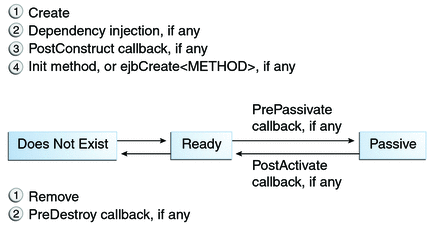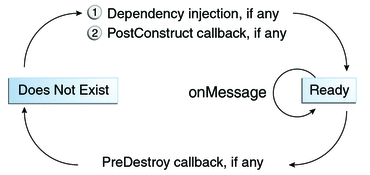The Lifecycles of Enterprise Beans (original) (raw)
2. Using the Tutorial Examples
3. Getting Started with Web Applications
4. JavaServer Faces Technology
7. Using JavaServer Faces Technology in Web Pages
8. Using Converters, Listeners, and Validators
9. Developing with JavaServer Faces Technology
10. JavaServer Faces Technology: Advanced Concepts
11. Using Ajax with JavaServer Faces Technology
12. Composite Components: Advanced Topics and Example
13. Creating Custom UI Components and Other Custom Objects
14. Configuring JavaServer Faces Applications
16. Uploading Files with Java Servlet Technology
17. Internationalizing and Localizing Web Applications
18. Introduction to Web Services
19. Building Web Services with JAX-WS
20. Building RESTful Web Services with JAX-RS
21. JAX-RS: Advanced Topics and Example
What Is a Message-Driven Bean?
What Makes Message-Driven Beans Different from Session Beans?
When to Use Message-Driven Beans
Using Enterprise Beans in Clients
Deciding on Remote or Local Access
Accessing Local Enterprise Beans Using the No-Interface View
Accessing Local Enterprise Beans That Implement Business Interfaces
The Contents of an Enterprise Bean
Packaging Enterprise Beans in EJB JAR Modules
Packaging Enterprise Beans in WAR Modules
Naming Conventions for Enterprise Beans
Further Information about Enterprise Beans
23. Getting Started with Enterprise Beans
24. Running the Enterprise Bean Examples
25. A Message-Driven Bean Example
26. Using the Embedded Enterprise Bean Container
27. Using Asynchronous Method Invocation in Session Beans
Part V Contexts and Dependency Injection for the Java EE Platform
28. Introduction to Contexts and Dependency Injection for the Java EE Platform
29. Running the Basic Contexts and Dependency Injection Examples
30. Contexts and Dependency Injection for the Java EE Platform: Advanced Topics
31. Running the Advanced Contexts and Dependency Injection Examples
32. Introduction to the Java Persistence API
33. Running the Persistence Examples
34. The Java Persistence Query Language
35. Using the Criteria API to Create Queries
36. Creating and Using String-Based Criteria Queries
37. Controlling Concurrent Access to Entity Data with Locking
38. Using a Second-Level Cache with Java Persistence API Applications
39. Introduction to Security in the Java EE Platform
40. Getting Started Securing Web Applications
41. Getting Started Securing Enterprise Applications
42. Java EE Security: Advanced Topics
Part VIII Java EE Supporting Technologies
43. Introduction to Java EE Supporting Technologies
45. Resources and Resource Adapters
46. The Resource Adapter Example
47. Java Message Service Concepts
48. Java Message Service Examples
49. Bean Validation: Advanced Topics
50. Using Java EE Interceptors
51. Duke's Bookstore Case Study Example
52. Duke's Tutoring Case Study Example
53. Duke's Forest Case Study Example
An enterprise bean goes through various stages during its lifetime, or lifecycle. Each type of enterprise bean (stateful session, stateless session, singleton session, or message-driven) has a different lifecycle.
The descriptions that follow refer to methods that are explained along with the code examples in the next two chapters. If you are new to enterprise beans, you should skip this section and run the code examples first.
The Lifecycle of a Stateful Session Bean
Figure 22-3 illustrates the stages that a session bean passes through during its lifetime. The client initiates the lifecycle by obtaining a reference to a stateful session bean. The container performs any dependency injection and then invokes the method annotated with@PostConstruct, if any. The bean is now ready to have its business methods invoked by the client.
Figure 22-3 Lifecycle of a Stateful Session Bean

While in the ready stage, the EJB container may decide to deactivate, orpassivate, the bean by moving it from memory to secondary storage. (Typically, the EJB container uses a least-recently-used algorithm to select a bean for passivation.) The EJB container invokes the method annotated @PrePassivate, if any, immediately before passivating it. If a client invokes a business method on the bean while it is in the passive stage, the EJB container activates the bean, calls the method annotated@PostActivate, if any, and then moves it to the ready stage.
At the end of the lifecycle, the client invokes a method annotated@Remove, and the EJB container calls the method annotated @PreDestroy, if any. The bean’s instance is then ready for garbage collection.
Your code controls the invocation of only one lifecycle method: the method annotated@Remove. All other methods in Figure 22-3 are invoked by the EJB container. SeeChapter 45, Resources and Resource Adapters for more information.
The Lifecycle of a Stateless Session Bean
Because a stateless session bean is never passivated, its lifecycle has only two stages: nonexistent and ready for the invocation of business methods. Figure 22-4 illustrates the stages of a stateless session bean.
Figure 22-4 Lifecycle of a Stateless Session Bean

The EJB container typically creates and maintains a pool of stateless session beans, beginning the stateless session bean’s lifecycle. The container performs any dependency injection and then invokes the method annotated @PostConstruct, if it exists. The bean is now ready to have its business methods invoked by a client.
At the end of the lifecycle, the EJB container calls the method annotated @PreDestroy, if it exists. The bean’s instance is then ready for garbage collection.
The Lifecycle of a Singleton Session Bean
Like a stateless session bean, a singleton session bean is never passivated and has only two stages, nonexistent and ready for the invocation of business methods, as shown in Figure 22-5.
Figure 22-5 Lifecycle of a Singleton Session Bean

The EJB container initiates the singleton session bean lifecycle by creating the singleton instance. This occurs upon application deployment if the singleton is annotated with the@Startup annotation The container performs any dependency injection and then invokes the method annotated@PostConstruct, if it exists. The singleton session bean is now ready to have its business methods invoked by the client.
At the end of the lifecycle, the EJB container calls the method annotated @PreDestroy, if it exists. The singleton session bean is now ready for garbage collection.
The Lifecycle of a Message-Driven Bean
Figure 22-6 illustrates the stages in the lifecycle of a message-driven bean.
Figure 22-6 Lifecycle of a Message-Driven Bean

The EJB container usually creates a pool of message-driven bean instances. For each instance, the EJB container performs these tasks.
- If the message-driven bean uses dependency injection, the container injects these references before instantiating the instance.
- The container calls the method annotated @PostConstruct, if any.
Like a stateless session bean, a message-driven bean is never passivated and has only two states: nonexistent and ready to receive messages.
At the end of the lifecycle, the container calls the method annotated@PreDestroy, if any. The bean’s instance is then ready for garbage collection.
Copyright © 2013, Oracle and/or its affiliates. All rights reserved. Legal Notices


